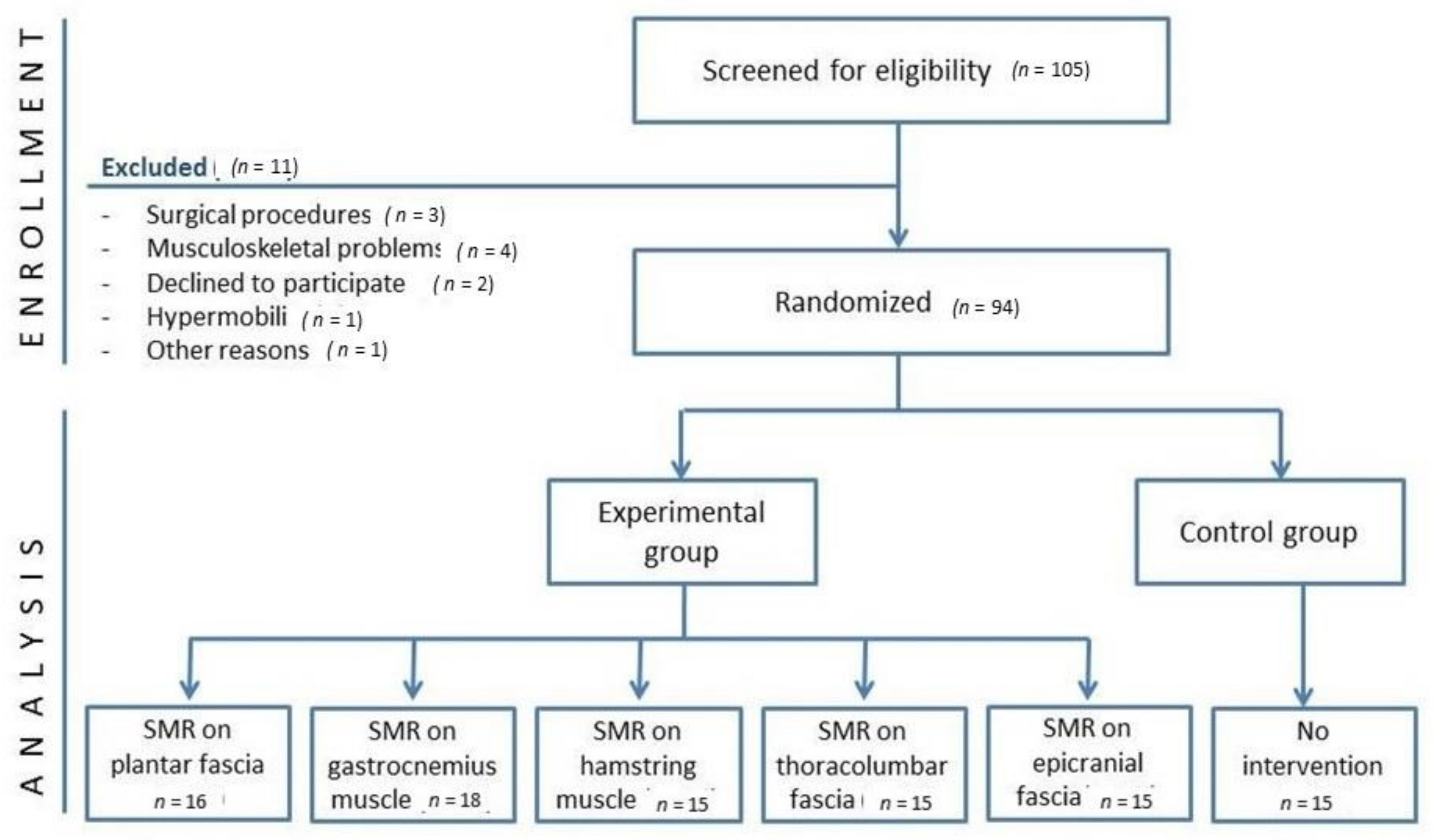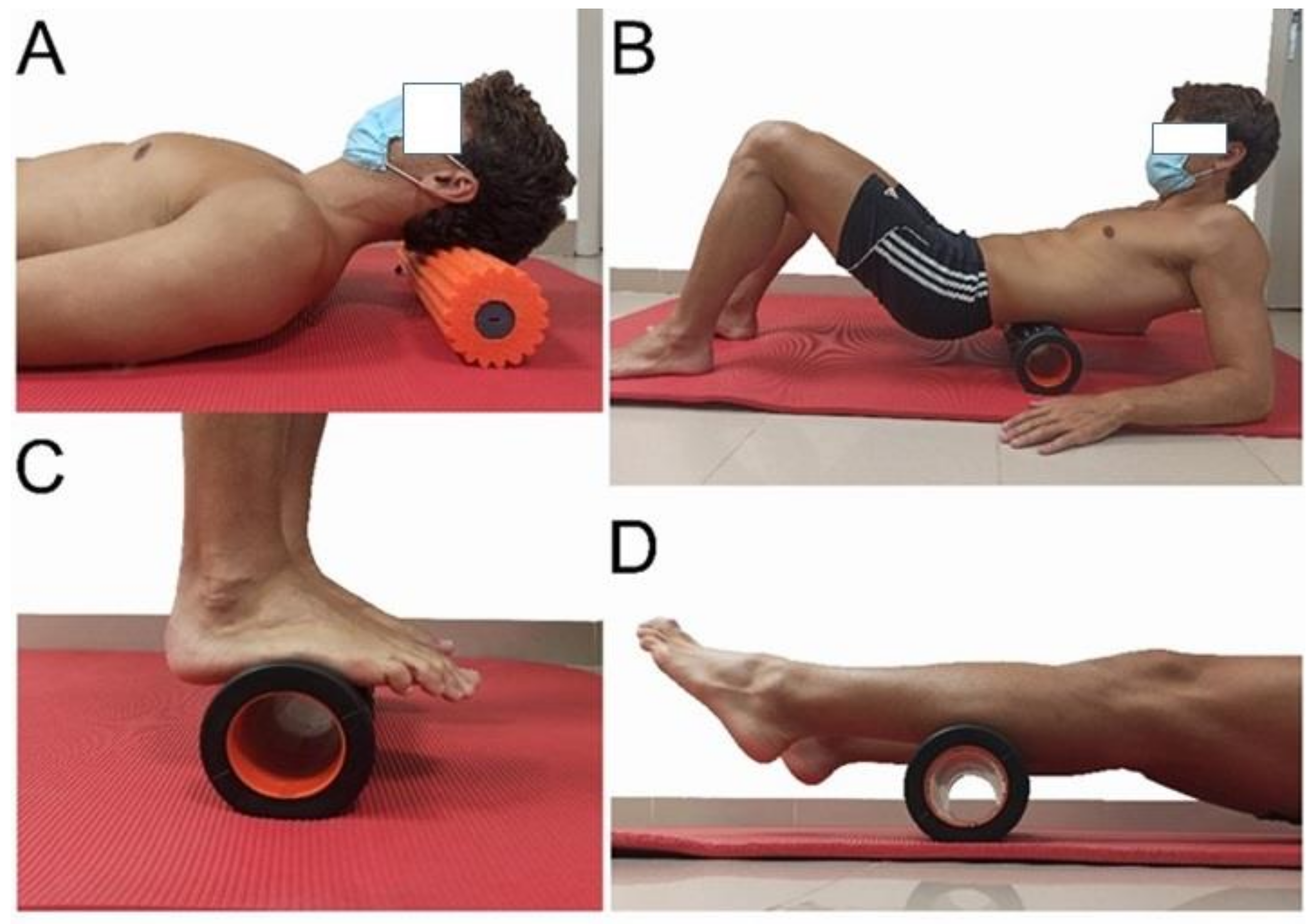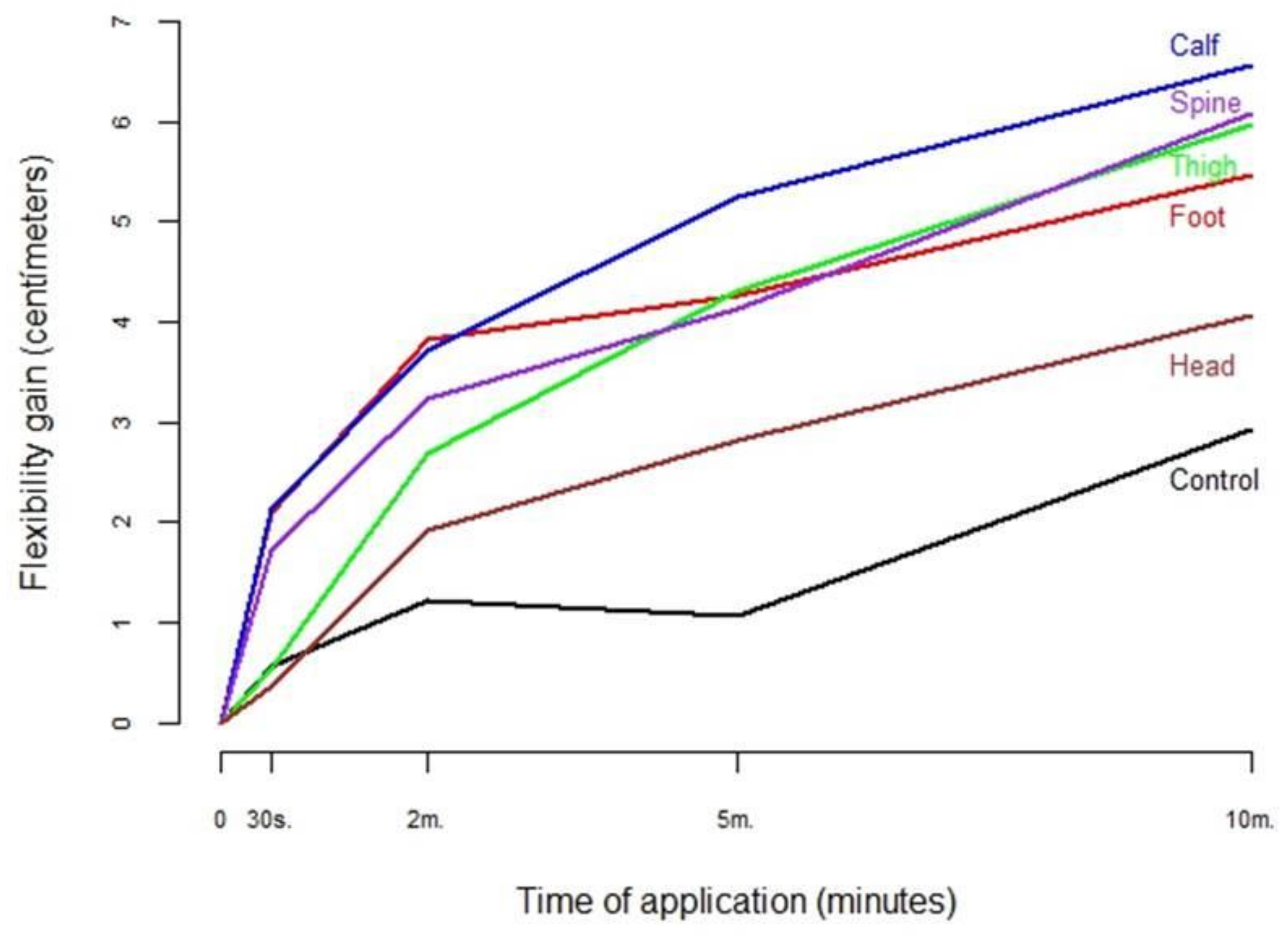Does Self-Myofascial Release Cause a Remote Hamstring Stretching Effect Based on Myofascial Chains? A Randomized Controlled Trial
Abstract
1. Introduction
2. Materials and Methods
2.1. Participants
2.2. Study Design
2.3. Variables and Measurements
2.4. Interventions
2.4.1. Control Group
2.4.2. Intervention Groups
2.4.3. Statistical Analysis
3. Results
4. Discussion
5. Conclusions
Author Contributions
Funding
Institutional Review Board Statement
Informed Consent Statement
Data Availability Statement
Acknowledgments
Conflicts of Interest
References
- Testut, L. Tratado de Anatomía Humana; Editorial Salvat: Barcelona, Spain, 1964. [Google Scholar]
- Rouviere, H.; Delmas, A. Anatomía Humana Descriptiva, Topográfica y Funcional; Tomo 3. Miembros: Barcelona, Masson, 2006. [Google Scholar]
- Gray, S. Gray’s Anatomy; Random House Digital, Inc.: Manhattan, NY, USA, 2011. [Google Scholar]
- Wilke, J.; Krause, F.; Vogt, L.; Banzer, W. What Is Evidence-Based About Myofascial Chains: A Systematic Review. Arch. Phys. Med. Rehabil. 2016, 97, 454–461. [Google Scholar] [CrossRef]
- Krause, F.; Wilke, J.; Vogt, L.; Banzer, W. Intermuscular force transmission along myofascial chains: A systematic review. J. Anat. 2016, 228, 910–918. [Google Scholar] [CrossRef]
- Myers, T.W. Anatomy Trains: Myofascial Meridians for Manual and Movement Therapists; Elsevier Health Sciences: Amsterdam, The Netherlands, 2009. [Google Scholar]
- Van Wingerden, J.; Vleeming, A.; Snijders, C.; Stoeckart, R. A functional-anatomical approach to the spine-pelvis mechanism: Interaction between the biceps femoris muscle and the sacrotuberous ligament. Eur. Spine J. 1993, 2, 140–144. [Google Scholar] [CrossRef]
- Vleeming, A.; Pool-Goudzwaard, A.L.; Stoeckart, R.; van Wingerden, J.; Snijders, C.J. The Posterior Layer of the Thoracolumbar Fascia| Its Function in Load Transfer from Spine to Legs. Spine 1995, 20, 753–758. [Google Scholar] [CrossRef]
- Sato, K.; Nimura, A.; Yamaguchi, K.; Akita, K. Anatomical study of the proximal origin of hamstring muscles. J. Orthop. Sci. 2012, 17, 614–618. [Google Scholar] [CrossRef] [PubMed]
- Stecco, C.; Corradin, M.; Macchi, V.; Morra, A.; Porzionato, A.; Biz, C.; De Caro, R. Plantar fascia anatomy and its relationship with Achilles tendon and paratenon. J. Anat. 2013, 223, 665–676. [Google Scholar] [CrossRef]
- Perez-Bellmunt, A.; Miguel-Perez, M.; Brugue, M.B.; Cabus, J.B.; Casals, M.; Martinoli, C.; Kuisma, R. An anatomical and histological study of the structures surrounding the proximal attachment of the hamstring muscles. Man. Ther. 2015, 20, 445–450. [Google Scholar] [CrossRef] [PubMed]
- Dadebo, B.; White, J.; George, K.P. A survey of flexibility training protocols and hamstring strains in professional football clubs in England. Br. J. Sports Med. 2004, 38, 388–394. [Google Scholar] [CrossRef]
- Woods, C.; Hawkins, R.D.; Maltby, S.; Hulse, M.; Thomas, A.; Hodson, A.; Football Association Medical Research Programme. The Football Association Medical Research Programme: An audit of injuries in professional football—Analysis of hamstring injuries. Br. J. Sports Med. 2004, 38, 36–41. [Google Scholar] [CrossRef] [PubMed]
- Tondelli, E.; Boerio, C.; Andreu, M.; Antinori, S. Impact, incidence and prevalence of musculoskeletal injuries in senior amateur male rugby: Epidemiological study. Physician Sports Med. 2021, 1–7. [Google Scholar] [CrossRef] [PubMed]
- Hennessey, L.; Watson, A.W. Flexibility and posture assessment in relation to hamstring injury. Br. J. Sports Med. 1993, 27, 243–246. [Google Scholar] [CrossRef]
- Witvrouw, E.; Danneels, L.; Asselman, P.; D’Have, T.; Cambier, D. Muscle flexibility as a risk factor for developing muscle injuries in male professional soccer players. Am. J. Sports Med. 2003, 31, 41–46. [Google Scholar] [CrossRef]
- Sherry, M.A.; Best, T.M. A comparison of 2 rehabilitation programs in the treatment of acute hamstring strains. J. Orthop. Sports Phys. Ther. 2004, 34, 116–125. [Google Scholar] [CrossRef] [PubMed]
- Gabbe, B.J.; Bennell, K.L.; Finch, C.F. Why are older Australian football players at greater risk of hamstring injury? J. Sci. Med. Sport 2006, 9, 327–333. [Google Scholar] [CrossRef] [PubMed]
- Engebretsen, A.H.; Myklebust, G.; Holme, I.; Engebretsen, L.; Bahr, R. Intrinsic risk factors for hamstring injuries among male soccer players: A prospective cohort study. Am. J. Sports Med. 2010, 38, 1147–1153. [Google Scholar] [CrossRef] [PubMed]
- Hatzantoni, K.; Khan, W.S. Lower Limb Muscle Strains. In Orthopedics of the Upper and Lower Limb; Springer: Cham, Switzerland, 2020; pp. 385–390. [Google Scholar]
- Rahr-Wagner, L.; Thillemann, T.M.; Mehnert, F.; Pedersen, A.B.; Lind, M. Is the use of oral contraceptives associated with operatively treated anterior cruciate ligament injury? A case-control study from the Danish Knee Ligament Reconstruction Registry. Am. J. Sports Med. 2014, 42, 2897–2905. [Google Scholar] [CrossRef] [PubMed]
- Backman, L.J.; Danielson, P. Low range of ankle dorsiflexion predisposes for patellar tendinopathy in junior elite basketball players: A 1-year prospective study. Am. J. Sports Med. 2011, 39, 2626–2633. [Google Scholar] [CrossRef]
- Watsford, M.L.; Murphy, A.J.; McLachlan, K.A.; Bryant, A.L.; Cameron, M.L.; Crossley, K.M.; Makdissi, M. A prospective study of the relationship between lower body stiffness and hamstring injury in professional Australian rules footballers. Am. J. Sports Med. 2019, 38, 2058–2064. [Google Scholar] [CrossRef]
- Pruyn, E.C.; Watsford, M.L.; Murphy, A.J.; Pine, M.J.; Spurrs, R.W.; Cameron, M.L.; Johnston, R.J. Seasonal variation of leg stiffness in professional Australian rules footballers. J. Strength Cond. Res. 2013, 27, 1775–1779. [Google Scholar] [CrossRef]
- Kovacs, M.S. The Argument against Static Stretching before Sport and Physical Activity. Athl. Ther. Today 2006, 11, 6–8. [Google Scholar] [CrossRef][Green Version]
- Blazevich, A.J. Adaptations in the passive mechanical properties of skeletal muscle to altered patterns of use. J. Appl. Physiol. 2019, 126, 1483–1491. [Google Scholar] [CrossRef] [PubMed]
- Mohr, A.R.; Long, B.C.; Goad, C.L. Effect of foam rolling and static stretching on passive hip-flexion range of motion. J. Sport Rehabil. 2014, 23, 296–299. [Google Scholar] [CrossRef]
- Cheatham, S.W.; Kolber, M.J.; Cain, M.; Lee, M. The Effects of Self-Myofascial Release using a Foam Roll Or Roller Massager on Joint Range of Motion, Muscle Recovery, and Performance: A Systematic Review. Int. J. Sports Phys. Ther. 2015, 10, 827–838. [Google Scholar] [PubMed]
- Halperin, I.; Aboodarda, S.J.; Button, D.C.; Andersen, L.L.; Behm, D.G. Roller massager improves range of motion of plantar flexor muscles without subsequent decreases in force parameters. Int. J. Sports Phys. Ther. 2014, 9, 92–102. [Google Scholar] [PubMed]
- Jay, K.; Sundstrup, E.; Sondergaard, S.D.; Behm, D.; Brandt, M.; Saervoll, C.A.; Jakobsen, M.D.; Andersen, L.L. Specific and cross over effects of massage for muscle soreness: Randomized controlled trial. Int. J. Sports Phys. Ther. 2014, 9, 82–91. [Google Scholar] [PubMed]
- Schleip, R. Fascial plasticity–a new neurobiological explanation: Part 1. J. Bodyw. Mov. Ther. 2003, 7, 11–19. [Google Scholar] [CrossRef]
- Castro-Piñero, J.; Chillon, P.; Ortega, F.; Montesinos, J.; Sjöström, M.; Ruiz, J. Criterion-related validity of sit-and-reach and modified sit-and-reach test for estimating hamstring flexibility in children and adolescents aged 6–17 years. Int. J. Sports Med. 2009, 30, 658–662. [Google Scholar] [CrossRef]
- Ayala, F.; de Baranda, P.S.; Croix, M.D.S.; Santonja, F. Reproducibility and criterion-related validity of the sit and reach test and toe touch test for estimating hamstring flexibility in recreationally active young adults. Phys. Ther. Sport 2012, 13, 219–226. [Google Scholar] [CrossRef]
- Mayorga Vega, D.; Viciana, J.; Cocca, A.; Merino Marban, R. Criterion-related validity of toe-touch test for estimating hamstring extensibility: A meta-analysis. Appear. Collect. 2014, 9, 188–200. [Google Scholar] [CrossRef]
- Ayala, F.; de Baranda, P.S. Fiabilidad absoluta de las pruebas sit and reach modificado y back saber sit and reach para estimar la flexibilidad isquiosural en jugadores de fútbol sala. Apunts. Med. L’esport 2011, 46, 81–88. [Google Scholar] [CrossRef]
- Hoeger, W.W.; Hopkins, D.R.; Button, S.; Palmer, T.A. Comparing the sit and reach with the modified sit and reach in measuring flexibility in adolescents. Pediatr. Exerc. Sci. 1990, 2, 156–162. [Google Scholar] [CrossRef]
- Clanton, T.O.; Matheny, L.M.; Jarvis, H.C.; Jeronimus, A.B. Return to play in athletes following ankle injuries. Sports Health 2012, 4, 471–474. [Google Scholar] [CrossRef]
- Bennell, K.; Talbot, R.; Wajswelner, H.; Techovanich, W.; Kelly, D.; Hall, A. Intra-rater and inter-rater reliability of a weight-bearing lunge measure of ankle dorsiflexion. Aust. J. Physiother. 1998, 44, 175–180. [Google Scholar] [CrossRef]
- Mahler, D.A.; Rosiello, R.A.; Harver, A.; Lentine, T.; McGovern, J.F.; Daubenspeck, J.A. Comparison of clinical dyspnea ratings and psychophysical measurements of respiratory sensation in obstructive airway disease. Am. Rev. Respir. Dis. 1987, 135, 1229–1233. [Google Scholar] [CrossRef]
- Wilson, R.C.; Jones, P.W. A comparison of the visual analogue scale and modified Borg scale for the measurement of dyspnoea during exercise. Clin. Sci. 1989, 76, 277–282. [Google Scholar] [CrossRef] [PubMed]
- Curran, P.F.; Fiore, R.D.; Crisco, J.J. A comparison of the pressure exerted on soft tissue by 2 myofascial rollers. J. Sport Rehabil. 2008, 17, 432–442. [Google Scholar] [CrossRef]
- Joshi, D.G.; Balthillaya, G.; Prabhu, A. Effect of remote myofascial release on hamstring flexibility in asymptomatic individuals–A randomized clinical trial. J. Bodyw. Mov. Ther. 2018, 22, 832–837. [Google Scholar] [CrossRef]
- Grieve, R.; Goodwin, F.; Alfaki, M.; Bourton, A.; Jeffries, C.; Scott, H. The immediate effect of bilateral self myofascial release on the plantar surface of the feet on hamstring and lumbar spine flexibility: A pilot randomised controlled trial. J. Bodyw. Mov. Ther. 2015, 19, 544–552. [Google Scholar] [CrossRef] [PubMed]
- Do, K.; Kim, J.; Yim, J. Acute effect of self-myofascial release using a foam roller on the plantar fascia on hamstring and lumbar spine superficial back line flexibility. Phys. Ther. Rehabil. Sci. 2018, 7, 35–40. [Google Scholar] [CrossRef]
- Patel, D.G.; Vyas, N.J.; Sheth, M.S. Immediate effect of application of bilateral self myo-fascial release on the plantar surface of the foot on hamstring and lumbar spine flexibility: A quasi experimental study. Foot 2016, 3, 7. [Google Scholar] [CrossRef]
- Kelly, S.; Beardsley, C. Specific and Cross-Over Effects of Foam Rolling on Ankle Dorsiflexion Range of Motion. Int. J. Sports Phys. Ther. 2016, 11, 544–551. [Google Scholar] [PubMed]
- Peacock, C.A.; Krein, D.D.; Silver, T.A.; Sanders, G.J.; von Carlowitz, K.A. An acute bout of self-myofascial release in the form of foam rolling improves performance testing. Int. J. Exerc. Sci. 2014, 7, 202. [Google Scholar] [PubMed]
- Hoskins, W.; Pollard, H. The management of hamstring injury—Part 1: Issues in diagnosis. Man. Ther. 2005, 10, 96–107. [Google Scholar] [CrossRef] [PubMed]
- Cheatham, S.W.; Stull, K.R. Comparison of a foam rolling session with active joint motion and without joint motion: A randomized controlled trial. J. Bodyw. Mov. Ther. 2018, 22, 707–712. [Google Scholar] [CrossRef]
- Reiner, M.M.; Glashüttner, C.; Bernsteiner, D.; Tilp, M.; Guilhem, G.; Morales-Artacho, A.; Konrad, A. A comparison of foam rolling and vibration foam rolling on the quadriceps muscle function and mechanical properties. Eur. J. Appl. Physiol. 2021, 121, 1461–1471. [Google Scholar] [CrossRef]
- Bialosky, J.E.; Bishop, M.D.; Price, D.D.; Robinson, M.E.; George, S.Z. The mechanisms of manual therapy in the treatment of musculoskeletal pain: A comprehensive model. Man. Ther. 2009, 14, 531–538. [Google Scholar] [CrossRef]
- Rodríguez-Sanz, J.; Malo-Urriés, M.; Lucha-López, M.O.; Pérez-Bellmunt, A.; Carrasco-Uribarren, A.; Fanlo-Mazas, P.; Corral-de-Toro, J.; Hidalgo-García, C. Effects of the Manual Therapy Approach of Segments C0-1 and C2-3 in the Flexion-Rotation Test in Patients with Chronic Neck Pain: A Randomized Controlled Trial. Int. J. Environ. Res. Public Health 2021, 18, 753. [Google Scholar] [CrossRef]




| Sample Size | Age | Gender | Hamstring Flex. | Dorsiflexion | |||
|---|---|---|---|---|---|---|---|
| Women | Men | Right | Left | ||||
| Total | 94 | 24.5 (5.6) | 42 (43.6%) | 52 (56.4%) | 25.1 (10.9) | 10.3 (3.5) | 10.3 (3.6) |
| Intervention | |||||||
| Control group | 15 | 26.1 (6.4) | 46.70% | 53.30% | 28.0 (12.0) | 10.5 (2.5) | 10.6 (3.2) |
| Plantar fascia | 16 | 25.0 (7.5) | 60.00% | 40.00% | 24.8 (13.2) | 9.3 (4.2) | 9.2 (4.3) |
| Posterior part of the sural fascia | 18 | 24.8 (5.3) | 18.80% | 81.30% | 21.9 (11.0) | 11.3 (3.5) | 11.7 (3.9) |
| Posterior part of the crural fascia | 15 | 23.8 (5.4) | 61.10% | 38.90% | 27.9 (11.0) | 9.0 (2.8) | 9.1 (1.9) |
| Thoracolumbar fasciae and erector muscles | 15 | 23.2 (4.2) | 26.70% | 73.30% | 24.1 (10.6) | 11.1 (3.6) | 11.2 (3.6) |
| Epicranial aponeurosis | 15 | 23.5 (6.4) | 46.70% | 53.30% | 23.4 (7.4) | 11.0 (3.7) | 10.5 (4.4) |
| p-value | 0.521 | 0.082 | 0.545 | 0.232 | 0.245 | ||
| Sit-and-Reach Test. Increase in Hamstring Flexibility | Lunge Test. Increase in Ankle Dorsiflexion | Gain vs. Perception of Physical Effort | |||||
|---|---|---|---|---|---|---|---|
| Group | 0–30 s | 0–2 min | 0–5 min | 0–10 min | Right | Left | Effort, Mean (SD) |
| Control group | 0.56 (−0.31; 1.45) | 1.23 (0.29; 2.17) | 1.07 (−0.21; 2.34) | 2.93 (0.28;5.58) | 0.13 (−0.36; 0.63) | 0.14 (−0.30; 0.57) | |
| Intervention groups | 1.23 (0.82; 1.65) | 2.78 (2.24; 3.31) | 3.68 (2.98; 4.38) | 5.22 (4.39; 6.05) | 0.64 (0.42; 0.86) | 0.66 (0.45; 0.86) | |
| Plantar fascia | 2.10 (0.73; 3.46) | 3.83 (2.26; 5.40) | 4.27 (2.45; 6.08) | 5.47 (3.38; 7.55) | 1.23 (0.38; 2.08) | 1.03 (0.41; 1.65) | 1.4 (1.7) |
| Posterior part of the sural fascia | 2.15 (1.12; 3.18) | 3.71 (2.59; 4.84) | 5.25 (3.81; 6.69) | 6.56 (4.51; 8.61) | 0.75 (0.24; 1.26) | 0.78 (0.11; 1.46) | 3.1 (0.7) |
| Posterior part of the crural fascia | 0.55 (−0.003; 1.11) | 2.69 (1.43; 3.95) | 4.31 (2.72; 5.89) | 5.97 (4.22; 7.72) | 0.86 (0.43; 1.28) | 0.94 (0.54; 1.35) | 2.1 (0.7) |
| Thoracolumbar fasciae and erector muscles | 1.73 (0.83; 2.63) | 3.23 (1.83; 4.63) | 4.13 (1.90; 6.36) | 6.07 (4.22; 7.91) | 0.43 (−0.13; 0.99) | 0.23 (−0.12; 0.59) | 1.2 (0.8) |
| Epicranial aponeurosis | 0.37 (−1.03; 1.76) | 1.93 (0.25; 3.62) | 2.83 (0.79; 4.86) | 4.07 (1.62; 5.91) | 0.37 (−0.12; 0.86) | 0.77 (0.16; 1.37) | 0.8 (1.0) |
| 30 s | 2 min | 5 min | 10 min | |
|---|---|---|---|---|
| Intervention groups overall | 23.50 | 53.2 | 70.5 | 100 |
| Plantar fascia | 38.4 | 70 | 77.8 | 100 |
| Posterior part of the sural fascia | 32.7 | 56.6 | 80 | 100 |
| Posterior part of the crural fascia | 9.2 | 45 | 72 | 100 |
| Thoracolumbar fasciae and erector muscles. | 28.0 | 52.8 | 67.7 | 100 |
| Epicranial aponeurosis | 9.1 | 47.6 | 69.8 | 100 |
Publisher’s Note: MDPI stays neutral with regard to jurisdictional claims in published maps and institutional affiliations. |
© 2021 by the authors. Licensee MDPI, Basel, Switzerland. This article is an open access article distributed under the terms and conditions of the Creative Commons Attribution (CC BY) license (https://creativecommons.org/licenses/by/4.0/).
Share and Cite
Fauris, P.; López-de-Celis, C.; Canet-Vintró, M.; Martin, J.C.; Llurda-Almuzara, L.; Rodríguez-Sanz, J.; Labata-Lezaun, N.; Simon, M.; Pérez-Bellmunt, A. Does Self-Myofascial Release Cause a Remote Hamstring Stretching Effect Based on Myofascial Chains? A Randomized Controlled Trial. Int. J. Environ. Res. Public Health 2021, 18, 12356. https://doi.org/10.3390/ijerph182312356
Fauris P, López-de-Celis C, Canet-Vintró M, Martin JC, Llurda-Almuzara L, Rodríguez-Sanz J, Labata-Lezaun N, Simon M, Pérez-Bellmunt A. Does Self-Myofascial Release Cause a Remote Hamstring Stretching Effect Based on Myofascial Chains? A Randomized Controlled Trial. International Journal of Environmental Research and Public Health. 2021; 18(23):12356. https://doi.org/10.3390/ijerph182312356
Chicago/Turabian StyleFauris, Paul, Carlos López-de-Celis, Max Canet-Vintró, Juan Carlos Martin, Luis Llurda-Almuzara, Jacobo Rodríguez-Sanz, Noé Labata-Lezaun, Mathias Simon, and Albert Pérez-Bellmunt. 2021. "Does Self-Myofascial Release Cause a Remote Hamstring Stretching Effect Based on Myofascial Chains? A Randomized Controlled Trial" International Journal of Environmental Research and Public Health 18, no. 23: 12356. https://doi.org/10.3390/ijerph182312356
APA StyleFauris, P., López-de-Celis, C., Canet-Vintró, M., Martin, J. C., Llurda-Almuzara, L., Rodríguez-Sanz, J., Labata-Lezaun, N., Simon, M., & Pérez-Bellmunt, A. (2021). Does Self-Myofascial Release Cause a Remote Hamstring Stretching Effect Based on Myofascial Chains? A Randomized Controlled Trial. International Journal of Environmental Research and Public Health, 18(23), 12356. https://doi.org/10.3390/ijerph182312356









